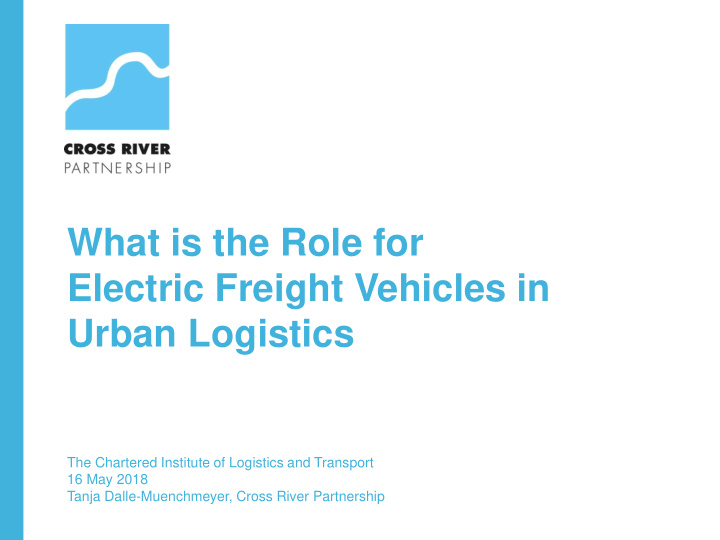



What is the Role for Electric Freight Vehicles in Urban Logistics The Chartered Institute of Logistics and Transport 16 May 2018 Tanja Dalle-Muenchmeyer, Cross River Partnership
Cross River Partnership 1
Contents 1 The Case for Electric Freight Vehicles 2 FREVUE Project 3 Power Requirements and Grid Infrastructure Capacity 4 Smart Electric Urban Logistics Project 5 Q&A | Delivering London’s Future Together | 2
The Case for Electric Freight Vehicles ● Traditionally focus on electrification of passenger cars and buses ● Freight vehicles contribute disproportionately to urban air pollution ● Freight movements remain crucial to well-functioning cities ● Fully electric freight vehicles offer no tailpipe emissions and significant reductions in CO 2 emissions | Delivering London’s Future Together | 3
FREVUE Freight Electric Vehicles in Urban Europe ● 4.5-year EU-funded project ● 8 cities, 32 partners ● To demonstrate the suitability of electric freight vehicles for inner city logistics | Delivering London’s Future Together | 4
FREVUE Consortium | Delivering London’s Future Together | 5
FREVUE Attitudes towards EFVs – project start Question to fleet managers: Are EFVs a viable alternative to ICEs? Before survey Yes 39% No 6% I am not 56% sure | Delivering London’s Future Together | 6
FREVUE Vehicles ● Deployed 86 fully electric vans and trucks ● <3.5 tonnes to 19 tonnes | Delivering London’s Future Together | 7
FREVUE Vehicles Supplier: Ginaf (NL) Payload: 4t; Load volume: 25 m3 Battery capacity: 120 kWh; Range: 125 km | Delivering London’s Future Together | 8
FREVUE Vehicles | Delivering London’s Future Together | 9
FREVUE Vehicles Supplier: EMOSS Payload: 7-8t; Load volume: 47 m3 Battery capacity: 200 kWh; Range: 200 km | Delivering London’s Future Together | 10
FREVUE Findings Data ● Dynamic vehicle data with state-of- charge from ● 10 operators and 83 vehicles ● Covering 757,000 km – 19 times around the Earth at the equator | Delivering London’s Future Together | 11
FREVUE Findings Km per kWh, temperature and weight group | Delivering London’s Future Together | 12
FREVUE Findings Energy usage taking GVW into account | Delivering London’s Future Together | 13
FREVUE Findings Range - Mixed messages Question to fleet managers: What are your range requirements? Before survey <100km 6% 100-199km 28% 200-299km 17% 300-499km 39% >500km 11% I am happy with what we… After survey <100km 50% 100-199km 17% 200-299km 17% 300-499km 0% >500km 11% I am happy with what we… 6% | Delivering London’s Future Together | 14
FREVUE Findings Environmental benefits ● Clear environmental benefits ● Resulting cost savings significant | Delivering London’s Future Together | 15
FREVUE Findings Noise ● Many factors contribute to road traffic noise , including vehicle, road, geo-spatial and weather related parameters ● However, EFVs only reduce engine noise ● In the FREVUE project, the impacts are impossible to measure ● Previous studies show that noise reductions from an EFV significant at lower speed | Delivering London’s Future Together | 16
FREVUE Findings Economics ● A positive business case is achievable for small and medium EFV ● For large EFVs this remains difficult | Delivering London’s Future Together | 17
FREVUE Findings Economics – Key factors ● Financial incentives ● Depreciation period ● Battery specification ● Km driven per day | Delivering London’s Future Together | 18
FREVUE Findings Impact of fast charging | Delivering London’s Future Together | 19
FREVUE Attitudes towards EFVs – project end Question to fleet managers: Are EFVs a viable alternative to ICEs? Before survey Yes 39% No 6% I am not 56% sure After survey Yes 72% No 11% I am not 17% sure | Delivering London’s Future Together | 20
EFV Uptake September 2017 McKinsey Report*: *Source: McKinsey (2017): New reality: electric trucks and their implications on energy demand | Delivering London’s Future Together | 21
EFV power requirements ● EFV power requirements and charging patterns different to passenger cars and buses An18t single-shifted truck with a 200kW battery in daily operation requires an average of 163 kWh per day to charge. In comparison, a medium-sized van requires approximately 30kWh per day ● Little diversity in charging patterns of large EFVs Large (over 12 tonnes) and medium (3.5 tonnes to 7.5 tonnes) EFVs within FREVUE tended to be charged only once a day in the late afternoon at the operator’s depot. ● Providing challenges but also opportunities | Delivering London’s Future Together | 22
Local grid infrastructure capacity ● Overall impact still low but local constraints pose problems ● FREVUE partner UPS encountered grid infrastructure constraints when charging all EFVs at the same time ● Infrastructure upgraded to charge up to 63 vehicles ● Such infrastructure upgrade has proven: Barrier to the large- – Costly, lengthy and disruptive scale deployment of – Non-incremental EFVs – Requiring investment in 3 rd party assets | Delivering London’s Future Together | 23
Smart Electric Urban Logistics ● An additional 20 EFVs at UPS central London depot – Bringing the number above the maximum that can theoretically be charged ● Design and implement an innovative smart charging system at this depot together with an energy storage system ● Design and implement a sophisticated network capacity assessment tool developed to take into account time of day variation in demand ● April 2017 to March 2019, funded by UK Office for Low Emission Vehicles | Delivering London’s Future Together | 24
Smart Electric Urban Logistics Active Network Management | Delivering London’s Future Together | 25
Smart Electric Urban Logistics (cont’d) ● Expected results – 5-year vision: Develop roadmap of how all 170 vehicles at UPS central London depot could be electric – Clarify how these results are transferable to other fleet operators | Delivering London’s Future Together | 26
Thank you Tanja Dalle-Muenchmeyer Programme Manager Electric Freight, CRP tanjadallemuenchmeyer@crossriverpartnership.org 27
Recommend
More recommend